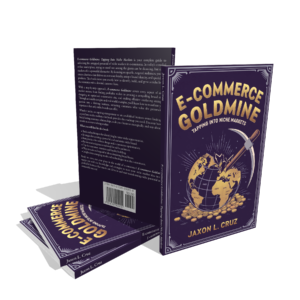E-commerce Goldmine Book Review – Complete Guide to Tapping Into Profitable Niche Markets

Discover how to transform your e-commerce business by tapping into profitable niche markets that your competitors are completely ignoring. Most online entrepreneurs struggle with fierce competition and razor-thin profit margins in oversaturated markets. This comprehensive guide reveals proven strategies for identifying and dominating untapped niche markets where customer loyalty runs deep and competition remains minimal.
“E-commerce Goldmine: Tapping Into Niche Markets” provides a strategic roadmap for entrepreneurs ready to escape the crowded mainstream markets and build sustainable, profitable businesses. Unlike generic e-commerce guides, this book focuses specifically on niche market identification and cultivation techniques that generate lasting customer relationships and premium pricing power.
What You’ll Discover
- Niche Market Identification Strategies: Learn proven techniques for discovering profitable micro-markets with minimal competition and high customer engagement potential
- Customer Loyalty Building Systems: Master the art of creating deep emotional connections with niche audiences that translate into repeat purchases and referrals
- Unique Brand Positioning Methods: Develop a distinctive brand identity that resonates specifically with your target niche and commands premium pricing
- Data-Driven Market Analysis: Utilize analytics tools and consumer behavior insights to validate niche opportunities before investing time and resources
- Targeted Marketing Campaign Creation: Design highly effective marketing strategies that speak directly to niche audience pain points and aspirations
- Sustainable Growth Frameworks: Implement scalable systems for expanding within your niche while maintaining focus and competitive advantages
Why This Book Matters
The e-commerce landscape has become increasingly competitive, making it essential for entrepreneurs to find blue ocean opportunities in specialized markets. This book addresses the critical need for niche market strategies by providing actionable insights based on real-world success stories. The author’s expertise shines through practical examples and step-by-step methodologies that eliminate guesswork from niche market entry.
Rather than competing on price with established giants, you’ll learn to create unique value propositions that attract dedicated customers willing to pay premium prices. The strategies outlined transform struggling general e-commerce stores into thriving niche market leaders with devoted customer bases and predictable revenue streams.
Key Features
This comprehensive ebook spans multiple chapters covering niche identification, customer psychology, brand development, and growth strategies. Available as an instant digital download, you’ll receive immediate access to actionable frameworks, market analysis templates, and customer research guides. The format allows for easy reading on any device, with printable worksheets for hands-on implementation. Also available as audiobook on Google Play Books and Spotify for convenient listening during commutes or workouts.
Frequently Asked Questions
How quickly can I identify profitable niche markets using these strategies?
The book provides systematic approaches that allow most entrepreneurs to identify 3-5 potential niche markets within 2-4 weeks of implementation. The key is following the data-driven research methods outlined in the early chapters, which streamline the discovery process significantly.
Will these niche market strategies work for established e-commerce businesses?
Absolutely. The book includes specific sections on transitioning existing general stores into niche-focused operations. Many case studies demonstrate how established businesses successfully pivoted to niche markets and dramatically improved profitability and customer satisfaction.
Do I need advanced technical skills to implement these e-commerce niche strategies?
No technical expertise required. The strategies focus on market research, customer understanding, and positioning rather than complex technical implementations. The author provides simple, actionable steps that any entrepreneur can follow regardless of technical background.
Get Your Copy Today
Transform your e-commerce business with this comprehensive niche market guide. Available for instant download at just $6.99, this ebook provides exceptional value compared to expensive business consultations or marketing courses. Also available as audiobook on Google Play Books and Spotify. Purchase your copy through all major ebook retailers including Apple Books, Barnes & Noble, and Kobo to begin building your profitable niche empire today.
Watch the Video Review

